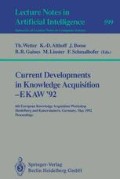Abstract
During the past decade, numerous real world knowledge-based systems have been built for the purpose of identification. Although most identification systems are based on the ability to observe and describe, few systems adress one of the first steps in knowledge acquisition which is how to acquire descriptions. Collecting this descriptive knowledge (observed facts) requires that a descriptive model (observable facts) has been previously defined. In addition, experience shows that the model depends on the goal which is pursued. In this paper, we present a tool and a methodology for the acquisition of the descriptive knowledge and the corresponding model which was designed primarily for identification. To achieve this goal, we have first used induction and have ran into redhibitory problems due to some limitations of this technology for processing incomplete descriptions. We present how we have stretched the technology in a case-based reasoning fashion to overcome these limitations. The tools and methodology have been developped and validated in the context of several real world applications.
Preview
Unable to display preview. Download preview PDF.
References
Bareis R. (1989). Exemplar-Based Knowledge Acquisition: A Unified Approach to Concept Representation, Classification, and Learning. Academic Press.
INSTIL (1989). Project Summary. ESPRIT Deliverable. Brussel, Belgium: Commission of Economic Communities.
Manago, M. (1986). Object-oriented Generalization: A Tool for Improving Knowledge Based Systems. Proceedings of the International Meeting on Advances in Learning, Les Arcs, France.
Manago, M. (1988). Intégration de Techniques Numériques et Symboliques en Apprentissage Automatique. PhD dissertation, University of Orsay, France.
Manago M., Kodratoff Y. (1990). “KATE: A Piece of Computer Aided Knowledge Engineering”, Proceedings of the fifth AAAI workshop on knowledge acquisition for knowledge based systems, Gaines B. & Boose J. eds, Banff (Canada).
Manago, M. & Conruyt, N. (to be published). “Using information technology to solve real world problems”, KEKOG, Schmalhoffer F. (ed), Springer Verlag.
Gruber T., Baudin C, Boose J., Weber J. (1991). “Design Rationale Capture as Knowledge Acquisition: Tradeoffs in the Design of Interactive Tool,” proc. of the eigth international workshop on Machine Learning, Morgan Kaufmann.
Minsky, M. (1975). “A framework for representing knowledge,” in The Psychology of Computer Vision. Winston P. H. ed, Mc Graw-Hill, New York 1975.
Nilsson, N. (1980). Principles of Artificial Intelligence. San Matteo, CA: Morgan Kaufmann.
Perray, M. (1990). “Etude Comparative Entre Trois Techniques d'Acquisition des Connaissances: Interview, Induction et Analyse Statistique pour Construire une Même Base de Connaissances”. Proceedings. of the Journées Informatique et Intelligence Artificielle. Paris, France.
Quinlan, J. R. (1983).“Learning efficient classification procedures and their application to chess end games”. In R. Michalski, J. Carbonell & T. Mitchell (eds), Machine Learning: An Artificial Intelligence Approach (Vol. 1). San Matteo, CA: Morgan Kaufmann.
Rouveirol C, Manago M. (1988). “Widening The Knowledge Acquisition Bottleneck”, proceedings of the third AAAI workshop on knowledge acquisition for knowledge-base systems, Banff (Canada),.
Schmalhofer F., Kühn O., Schmidt G. (1991). “Integrated knowledge acquisition from text, previously solved cases and expert memories”. Applied artificial intelligence 5, pp 331–337.
Author information
Authors and Affiliations
Editor information
Rights and permissions
Copyright information
© 1992 Springer-Verlag Berlin Heidelberg
About this paper
Cite this paper
Manago, M., Conruyt, N., Le Renard, J. (1992). Acquiring descriptive knowledge for classification and identification. In: Wetter, T., Althoff, KD., Boose, J., Gaines, B.R., Linster, M., Schmalhofer, F. (eds) Current Developments in Knowledge Acquisition — EKAW '92. EKAW 1992. Lecture Notes in Computer Science, vol 599. Springer, Berlin, Heidelberg. https://doi.org/10.1007/3-540-55546-3_52
Download citation
DOI: https://doi.org/10.1007/3-540-55546-3_52
Published:
Publisher Name: Springer, Berlin, Heidelberg
Print ISBN: 978-3-540-55546-9
Online ISBN: 978-3-540-47203-2
eBook Packages: Springer Book Archive

